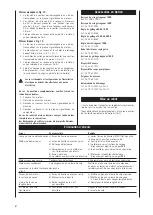
12
As a support for the spline end and the assembly key the
cylindrical screw M5x 40 with two nuts M5 is attached
to the left side of the frame clamp. (Fig. 2)
Assembly of the saw blade/
Changing of the saw blades, Fig. 9
Assembly and changing of the saw blades is only permitted
when the power plug is unplugged.
Use only Original scheppach Saw blades. Use of foreign
products is not covered by the guarantee.
1. Lower saw blade height position.
2. Put saw blade from below on the basic flange of
the motor shaft. Watch the locking mechanism while
plugging in the flanges.
3. Upon tightening the hexagonal screw with the open-
end wrench SW17 supplied, the saw blade flange can
be held back with the box wrench SW46.
Splitting wedge adjustment, Fig. 10
The adjustment of the splitting wedge has to be carried
out after every saw blade change.
The splitting wedge has to align with the saw blade. The
distance between saw blade and splitting wedge should
not exceed 8 mm.
The splitting wedge is an important protection device,
which leads the work piece and the closing of the cutting
joint behind the saw blade and by this prevents the back-
stroke of the work piece.
Pay attention to the thickness of the splitting wedge (see
punched numbers on the splitting wedge). The splitting
wedge should not be thinner than the total body of the
saw blade and not thicker than the width of the cutting
joint.
Implementation
Please take notice of the security information.
The implementation of the machine should only take place
after completely installed protection and security facilities.
After connection to the supply system the machine is
ready for operation.
The hood should be placed onto the work unit after every op-
eration.
For covered cutting remove the hood after loosening the
wing-nut.
Oblique positioning of the saw blade, fig. 11
1. After loosening the clamping lever the saw blade is
variably adjustable from 90° to 45° (see Scale).-
Try out the 90°- and the 45°-position before every operation!
Carry out trial cut!
Readjust the adjusting screws 1 and 2 if necessary.
Height adjustment of the saw blade
You can adjust the height by using a hand wheel on
the front side of the machine.-
The necessary respective cutting height can now be
accurately set.
For secure and clean work choose a small saw blade spigot
as your work piece.
Longitudinal cutting, Fig. 12
Use the longitudinal rabbet for parallel cutting. For cut-
ting jobs over 120 mm use the rabbet ruler with the high
rabbet side (1) and for cutting jobs less than 120 mm the
one with the lower rabbet side (2). Lead the work piece
with the enclosed spline end.
Transverse cutting, no Fig.
For oblique and corner cutting use the oblique cutting
gauge or the sliding tables (optional accessory). The set-
ting scale for the oblique cutting gauge reaches from 0
– 90°.
Notes on working
Working on circular saw benches
Cutting narrow work pieces, Fig. C
(Width of work piece less than 120 mm)
Tool:
circular saw blade for length cuts
Work step:
Adjust the parallel stops to the width of the intended work
piece. Feed work piece with both hands. In the area of the
saw blade use the push stick and push the work piece be-
yond the splitting wedge. When working with shorter work
pieces use the push stick from the very beginning.
Cutting strips and corners, Fig. D
Tool:
Circular saw blade for line cuts
Work step:
Install parallel stops with a flatter guide side or use lower
auxiliary stops. Feed the work piece with a push board un-
til the end of the work piece is in the area of the splitting
wedge. Prevent longer work pieces from tipping over at the
end of the cutting process by using the bench extension.
Note:
Attachments which require a connection to parts of
the machine must be bolted down. Screw clamps can only
provide secondary connections to machines.
Cross-cutting narrow work pieces, Fig. E
Tool:
Fine toothed cross cut blade
Work step:
Adjust diversion strip so that sawed off pieces cannot
come into contact with the protruding part of the saw
blade. Feed the work piece only with the cross stop or with
the cross slide. Do not use hands to remove excess wood
from the area of the work piece.
Blind cutting, mortise and tenon, Fig. F + G
Work step:
Adjust the splitting wedge to be the rear machine cover
(Setting for blind cut). Adjust the parallel stop to the
mortise or tenon dimension and secure against sideward
movements.
Feed work piece with feeding batten. Right hand secures
the work piece against falling over. Do not place hand on
the forward edge of the work piece.
After cutting, return the feeding batten with the work
piece. The measurements of the work piece receiver rebate
of the feeding batten must correspond to the work piece
measurements. In order to apply sufficient pressure to the
work piece, the notching depth must be approx 1 mm less
than the thickness of the work piece. If the mortise depth
or the tenon height attains the measure of the stop height
C, than a detachable board B secured with screws A can
be used for raising the stop.
















































